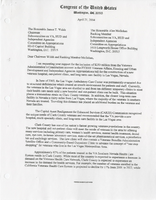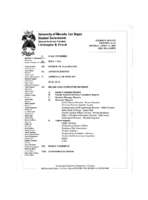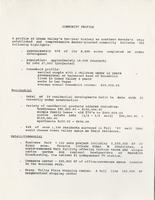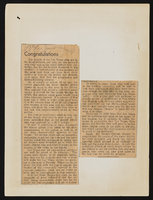Search the Special Collections and Archives Portal
Search Results
#67603: Thompson, William "Bill" - Farewell Party, 2010 April 29
Level of Description
Archival Collection
Collection Name: University of Nevada, Las Vegas Creative Services Records (2010s)
Box/Folder: Digital File 00
Archival Component


Transcript of interview with Alfred "Al" Guzman by Barbara Guzman, March 1, 1981
Date
Archival Collection
Description
On March 1, 1981, Barbara Guzman interviewed her father, Alfred “Al” Guzman (born 1932 in El Paso, Texas) about his life in Southern Nevada. Guzman first talks about his occupational history, including his then-current career in public relations for the Sands Hotel and Casino. He then talks about Las Vegas, including social changes, changes in the gaming industry, and mob influence in the casinos. He also talks about Reno, how his job affects the public, and the MX Missile system.
Text

Meeting minutes for Consolidated Student Senate, University of Nevada, Las Vegas, April 14, 2003
Date
Archival Collection
Description
Text
J. T. McWilliams Family Papers
Identifier
Abstract
The collection consists of letters, greeting cards, survey maps, newspaper clippings, legal papers, photographs, collected recipes, land sales and expense journals, and survey reference books. The material was created or collected by pioneering Nevada surveyor, engineer, and real estate entrepreneur J. T. (John Thomas) McWilliams and his wife, Iona, between 1900 and 1968.
Archival Collection
Paz, Jacob, Dr.
Dr. Jacob Paz was born November 14, 1938 and grew up in an agricultural environment in Israel where he attended Kadoorie High School. After his graduation, Paz joined the Israeli army. He attended technical school for two years and started working for the Israel Atomic Energy commission in Dimona, Israel, making atomic bombs. Paz was accepted into University of California Davis, and moved to the United States to study veterinary medicine.
Person
MacDonald Ranch Development Records
Identifier
Abstract
The MacDonald Ranch Development Records (1972-2010) contain correspondence, maps, land assessments and investigations, master plans, and architectural, civil engineering, and landscape drawings primarily detailing the community development process of MacDonald Ranch, a master-planned community in southwest Henderson, Nevada.
Archival Collection
landscapes (representations)
creative works, usually two-dimensional, depicting an outdoor scene dominated by the land, hills, fields, sky, trees, fields, rivers or other bodies of water, and other natural elements. Landscapes may include a near point of view in the foreground, but also usually depict a view into the distance. Landscapes may contain architecture or figures, but the primary focus remains the land. When an ocean, sea, or other large body of water dominates the picture, use "seascapes." For actual areas of land rather than depictions, use "landscapes (environments)"
Authority Sources
Material Type


